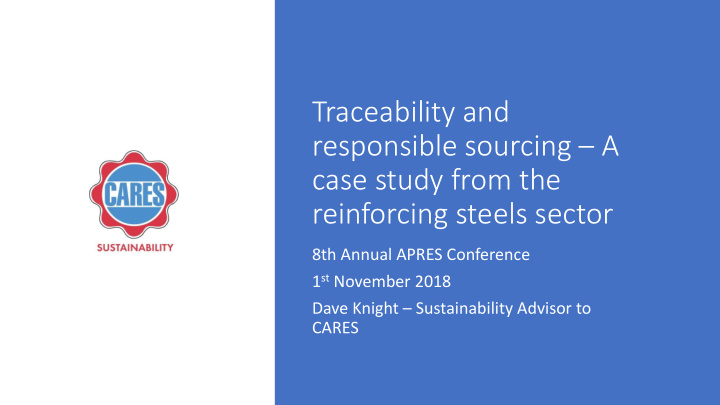



Traceability and responsible sourcing – A case study from the reinforcing steels sector 8th Annual APRES Conference 1 st November 2018 Dave Knight – Sustainability Advisor to CARES
The ability to discover information Traceability about where and how a product was made and through its full life cycle
Raw materials Steel Mined ores: Raw material sources • Predominantly Iron Ore supply • 20+ other metallic elements Large scale mining Other inputs: Artisanal mining chain • Coke Chemical Industry • Limestone Energy Industry • Other non-metallic elements • Energy Scrap Steel: Traceable in certain regions, e.g. UK Commodity product with limited traceability globally Other inputs: Sources: Adapted from CIRIA report • Mined Ores C767 - Responsible sourcing. A • Coke handbook for the construction industry • Limestone With additional stages added. • Other non-metallic elements Steelfacts from Worldsteel.org. (Global • Energy Averages)
CARES Traceability system • All CARES steels are 100% traceable at a batch and product level to the original steel producer. Traceability starts with a unique cast number. Molten steel is cast, rolled, and then delivered to the fabricator. During cutting or bending the cast number is accompanied by a ‘bar schedule reference’ and ‘bar mark’ before delivery and use. Batches of product will carry the labels shown.
Relevant scheme criteria • 1.4.1 The organization shall complete an initial review/due diligence by assessing and documenting its adverse impacts (risks) and beneficial impacts (opportunities). It shall consider these using a life cycle perspective, the degree of influence or control it has over the impacts and periodically update them should it identify a change
Relevant scheme criteria • 1.7.2.2 The organization shall ensure traceability throughout the full life cycle and made the extent of traceability publicly available • 1.7.4.1 The organization should map sustainability issues to purchase categories and to relevant suppliers • 1.7.4.2 The organization shall publish a Responsible Sourcing Policy/an Ethical Supply Chain Practices Policy/ a Sustainable Procurement Policy or equivalent reflecting management's commitment to promote Responsible Sourcing. Its scope shall be aligned to the environmental and social impacts as listed in CARES SCS Applicable Appendix's Section 3. (vi)
Environmental and social impacts in CARES SCS Applicable Appendix's Section 3. (vi) 2.1. Global Warming Potential (GWP) and 3.1. Human Rights, Slave Labour, Child Labour, Greenhouse Gas Emissions (GHG) Workers’ Conditions, Fair Labour Conditions (Fair Treatment, Fair Wages, Employment Equality, 2.2. Transport Impacts Equality in respect of Gender, Ethnicity, Religion, Political Persuasion, Sexuality, Disability), Working 2.3. Primary Material Use and Materials Hours, Overtime, Holidays, Freedom to join Trade Efficiency Unions (Freedom of Association) 2.4. Energy and Water Use 3.2. Safe and Healthy Working Conditions 2.5. Biodiversity and Eco-toxicity 3.3. Stakeholder Complaints and Prosecutions 2.6. Waste and By-Product Management, 3.4. Skills and Training (Development of Employees) Recyclability and Recycled Content 3.5. Community Relations and Community 2.7. Land Remediation Initiatives 2.8. Reporting Environmental Performance to 3.6. Reporting Social Performance to Stakeholders Stakeholders 3.7. Social Accountability Management System and 2.9. Environmental Management and ISO 14001 SA 8000
Relevant scheme criteria • 1.7.4.3 The supplier selection and evaluation system should include consideration of the environmental and social impacts listed in CARES SCS Applicable Appendix's Section 3. (vi) • 1.7.4.4 The organization shall complete the "KPI" within this workbook for "Suppliers' Management System Approvals" (ISO 9001, ISO 14001, OHSAS 18001/ISO 45001) • 1.7.4.5/6/7 The organization should assess extent of suppliers’ […] management system approvals • 1.7.4.8 Sustainability training should be offered and provided to suppliers
Responsible sourcing opportunities • Global, principles led, approaches with local implementation • Wider adoption of standards • Better regulation and enforcement across all of value chain • Collaboration at all stages of the value chain • Increased transparency from traders and commodity markets • Improved monitoring, greater transparency and adoption of higher standards further up the supply chain for all inputs • Improved systems, data sharing and reporting
Recommend
More recommend